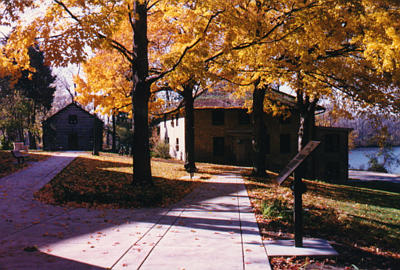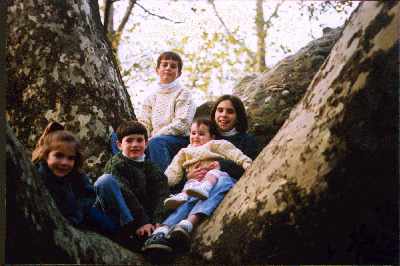
Notre Dame's Grotto / by Dorothy V. Corson


An Indian Baptism
The visiting German priest goes on to describe an Indian baptism he performed at St. Mary's Lake during his visit there:
Near the mission house, whose interior I have briefly described for you already, a little hill rises, in the shape of a mountain ridge, which extends in a straight line for several hundred steps, and faces with its precipitous side the lake with which I made you acquainted in the first chapter of this letter.
On this ridge now you see several tents made from rush mats, pitched in the simplest way. In front of them you still see the smoking ashes of their fires, on which the "redskins" prepared their meals in the gypsy way. The men, having said their prayers in the chapel of the wilderness, now stroll around in the temporary camp altogether carefree and unconcerned about the activities of the neighborhood, and puff away on their pipes with wonderful manners. The squaws, the born Cinderellas in the family life of the natives in America, are industrious and active in their traveling household, and clean and tidy up the pieces of their household possessions, which are easily counted. The little savages, for want of a bathtub, get their morning refreshments in the lake, while the older boys are following the horses in puris naturalibus, which, hobbled at the bottom of their front legs, can only hop like frogs, but while doing so take their fill of lush prairie grass in the broad meadow on the banks of the lake. Walk now with me up the hill, where I will baptize an Indian born this morning. I will celebrate the baptism in front of the tent where the mother of the child is. She came yesterday riding à la Turc with the Indian train and is lying now fresh and healthy under the rush roof. She is wrapped tightly into a woolen blanket and of her body only the head with its long black hair and glowing eyes is visible. Her whole situation brings instinctively back to my mind the Egyptian mummies I have seen, even more so since her glance is focused on me without movement. In the tent everything is unusually clean, though nothing remains so that you, as a doctor, will be reminded of the delivery that took place here only a few hours ago. A plain mat has been spread out for me in front of the tent; the beautiful blue sky is arching above me like a dome made from lapis lazuli; the clear surface of the lake reflects the cheerful splendor of the sky; the manifold greens of the nearby bushes, like the fine cedar, tulip, and oak trees of the forest on the opposite side, decorate the lake, which now is viewed as the font; and the grass slope with its decoration of far-western flowers, which stretches all the way to the lake, serves as the carpet of the imposing house-chapel in God's wonderful temple of nature.
To a small tree next to me in front of the Indian mother's tent I am fastening a Crucifix, sign of eternal salvation and highest "humanity", which I used to carry with me on my trips. So the little tree at St. Mary of the Lake becomes a beautiful symbol of the tree of deliverance and reconciliation, which would solemnly enable the son of the wilderness to participate in it through baptism. The baptismal water is ready; the white child of the redskin rests on the arms of its godfather; a group of Indian faces surrounds me, wildly painted but calm in their expressions; a Canadian person who understands the Potawatomi language is at my side; the baptism is carried out; the savages are praying in their language the prayer of the Lord, the apostolic confession of faith; and the child is named Anthony. St. Anthony is your patron saint and that of several other friends, to whom, as to my loved ones at home, I want to declare in this way my constant remembrance. The child's father's name is "Little Crane"; I will always remember his heartfelt thanks for the admittance of his son into the great association of salvation.(208)
"So the little tree at St. Mary of the Lake becomes a beautiful symbol of the tree of deliverance and reconciliation, which would solemnly enable the son of the wilderness to participate in it through baptism." This line of the German missionary's interesting narrative could have been written about the Legendary Sycamore itself, which would have been but a stone's throw away from the little tree on the hilltop he is describing. In its own way, it has also become a witness to, and a symbol of, the participation of the sons of the wilderness in the history of the founding of the University over one hundred and fifty years ago.
**********
There's an interesting parallel to Notre Dame's Sycamore. Sorin also founded St. Edward's University in Austin, Texas in 1871. He chose the site of its Main Building for its hilltop view and a huge live oak growing there. It was called the "Umbrella Tree" and the "Lone Tree" because it was the only tree on the spot. The live oak is quite an impressive tree situated near the Main Building and just above the location of the Grotto. Directly in front of the tree is a large plaque. On it are the words, "Sorin's Tree." Could Sorin have chosen the hilltop setting and preserved the tree because of the huge sycamore at Notre Dame?
Recently an article appeared in the South Bend Tribune featuring a photograph of Michigan's largest sycamore. This particular tree had been core-sampled, a risk that would never be taken with the campus sycamore, already judged the largest and oldest sycamore in St. Joseph County. Michigan's Champion Tree's circumference is listed as 256" and its age has been determined to be 250 to 260 years old. At last, a similar sized tree to compare measurements with to determine the approximate age of the Legendary Sycamore. Huge sycamores of comparable size were taken down at the Culver Military Academy earlier, but an inquiry about them came too late, the stumps had been removed without counting the rings to age them.
Measurements and the ring count of the core-sampled Champion Michigan tree were compared with the one at Notre Dame which is 244" in circumference. Using the formula provided by Purdue, it is likely that the approximate age of Notre Dame's sycamore could be, as it was earlier thought to be, from 200 to 240 years old. Using the conservative 200 year figure would mean it was present on campus in the late 1700s. A time when there was much hostility between the early white settlers and the Indians when the Indian legend was said to have taken root. Which means it could have been a fanciful tale, fiction based on fact, or in the category of an "urban" or "rural" legend attached to the tree.
A special trip to visit the Michigan tree revealed it to be a massive kingly specimen. However, it is without a place to perch nor is it as friendly and inviting as Notre Dame's Landmark Sycamore which seems to beckon people to lounge in its sheltering arms, as the children of Tish and Patrick Holmes -- Mary Kate, Christopher, Patrick, Kelly and Kielty -- are doing in this photograph

This venerable old tree, judged to be the oldest and largest sycamore in St. Joseph County, is more than worthy of homage. If the legend draws attention to that fact, it deserves to be associated with the stately old tree on the Grotto lawn. Thus far the story holds up very well.
One thing is certain. The Legendary Sycamore is definitely alive and well, as real now as it was on a summer day in the life of a Black Robe missionary; when Chief Little Crane's son was born and baptized, Anthony, in 1840, at Ste.-Marie-des-Lacs, now the University of Notre Dame.
This majestic old sycamore has been immortalized by countless student pictures taken up in it, and in front of it, from the early part of this century. The wife of a member of the University faculty, James Murphy, now retired, said they have pictures of each of their children taken in the sycamore at various times when they took them to the campus.
Father Schidel, who first suggested checking theThe Domes for early pictures of the tree, presented a 1931 copy of The Dome, and opened it to the only identified photograph of the sycamore. Under it were the words Father Cavanaugh had used to describe it -- The Vengeance Tree. He then produced a photo album of his early days on campus and another 1931 snapshot of the sycamore. Three students stood in front of the tree and one was standing up in it. When asked who was in the tree, he grinned and said, "It was me."
During its long life this magnificent Sycamore has seen it all. It has become a witness tree -- a silent sentinel standing guard over the campus and the Grotto -- watching not only the heartaches and the sorrow, but also the joys, of an endless parade of people passing to and from the Grotto.
And it has endured, as life endures, generation after generation, as one of the last antique lords of the Indian hunting grounds. Only God knows how many years its graceful limbs and lovely foliage have embraced the campus grounds, how many photographs(209) have been taken in front of it, and how many, from little on up, have been cradled in its sturdy branches.
How providential, that two such historic and legendary spots on campus -- The Grotto and The Legendary Sycamore -- share the same lovely lakeside setting. Perhaps it is best that no positive proof of this story ever be found and it remain the legend that it is. If it were proven beyond a shadow of doubt then it would no longer be a legend. It would be history and not nearly as fascinating a tale to tell.